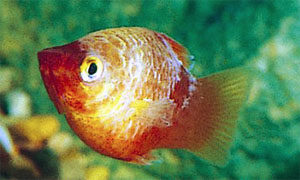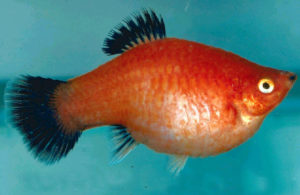28 Apr Fish Diseases, Symptoms, Diagnosis, treatment and cure
To be able to distinguish the diseases in our aquarium during the existence of our fish, we must keep in mind the normal conditions in which our animals live; so if we notice abnormal behaviors, such as too abrupt movements, or static and lateral positions, or lowered fins and tight tails, we should be alarmed. The fishes in our aquarium are subject to diseases caused by organisms introduced from outside, from poor hygiene or from not correct water values. The most common diseases in home aquariums are the following, let’s see how to identify and how to cure them.
 COLUMNARIS DISEASE:
COLUMNARIS DISEASE:
(Flexibacter columnaris) presence of whitish areas on the mouth, scales, the edges of the fins that are squashed. Ulcers, erosions and skin necrosis. The lesions start on skin and fins to become systemic. Caused by poor hygiene, increased concentration of ammonia, poor concentration of oxygen. Massive change of water or buy a specific product in shop.
 DROPSY DISEASE:
DROPSY DISEASE:
(Birnavirus, Pseudomonas, Corinebacterium) accumulation of fluid in the abdominal cavity, swelling and lifting of the scales. Caused by incorrect feeding, cold or hot change temparature, stress. It is advisable to change water and add bioconditioner, buy specific antibiotic products from the shop.
 HOLE DISEASE:
HOLE DISEASE:
(Hexamita salmonis, Spironucleus elegans) The signs include pitting-type lesions on the head and lateral line. The condition may be mild at first, but if changes to the environment and treatment are not initiated, the holes will become larger and secondary bacterial and fungal infections will develop. These lesions can eventually create a severe infection and the fish becomes systemically ill with loss of appetite and death. Improve water quality, and improve vitamin/mineral supplementation and nutrition. A common treatment for infection with Hexamita includes the addition of the antibiotic metronidazole in to the tank housing the infected fish. Improving nutrition by adding fresh or frozen meaty foods or vegetables. Add antibiotics such as Maracyn, Kanacyn, or Furan may be needed. When treating this disease, try to use a separate treatment tank and treat as soon as the first symptoms appear.
 ICK, WHITE SPOTS DISEASE:
ICK, WHITE SPOTS DISEASE:
(Ichfhyophthirius multiphliis) shite spots on all body, usually attacks fish that are stressed, which can be caused by factors including rapid temperature change and pH fluctuations. Make a partial water change and use specific antibiotics. increase temperature to 30/32° Celsius and good water quality will help prevent infections. I same case qe can use olso salt water, but only in another tank.
 RAGGED TAIL FIN DISEASE:
RAGGED TAIL FIN DISEASE:
A bacterial infection may cause this tail and fin rot in susceptible fish those who are bullied or injured by other fishes especially in aquariums with poor conditions. Test the aquarium water to review overall water quality and make a partial water change to ensure healthy conditions. If the clamped fins are the result of infections use a antibiotics treatment or salt water treatment.
 SKIN MYCOSIS DISEASE:
SKIN MYCOSIS DISEASE:
(Saprolegnia, Achlya, Dictyuchus) Has a fungal origin, you can see whitish filaments first on skin and fins, then expands and wraps the entire body of the fish. It is an easily fatbleable disease, use specific antifungal products exist in the market.
 SKIN AND BRANCHES WORMS: (Gyrodactylus elengas, cabitis, medius gracilis / Dactylogyrus auriculatus), usually attack cyclides, fish have a slimming, swim badly, rub on the furniture or on the bottom. They are easily detectable and mechanically removed being careful to not injure the fish, but also an antiparasitic agent product.
SKIN AND BRANCHES WORMS: (Gyrodactylus elengas, cabitis, medius gracilis / Dactylogyrus auriculatus), usually attack cyclides, fish have a slimming, swim badly, rub on the furniture or on the bottom. They are easily detectable and mechanically removed being careful to not injure the fish, but also an antiparasitic agent product.
 SWIM BLADDER INFLAMMATION: Caused mainly by bacteria and parasites; Congenital abnormalities are common, the bladder is a fundamental organ for maintaining the proper arrangement of the fish depending on the various depths to which it moves. An infectious or congenital problem can easily alter the position of the fish in the water, which is why belly-tailed fish, standing on the surface and having difficulty dipping. Depending on the cause, treatment with a bioconditioner may be expected, but if the problem is of a congenital nature, you cant do much.
SWIM BLADDER INFLAMMATION: Caused mainly by bacteria and parasites; Congenital abnormalities are common, the bladder is a fundamental organ for maintaining the proper arrangement of the fish depending on the various depths to which it moves. An infectious or congenital problem can easily alter the position of the fish in the water, which is why belly-tailed fish, standing on the surface and having difficulty dipping. Depending on the cause, treatment with a bioconditioner may be expected, but if the problem is of a congenital nature, you cant do much.
In base of all these diseases, it is advisable to carry out the treatments by separating the affected fish, in dedicated tanks, either to avoid contagion or to avoid drug contamination on plants, other fish or furnishings, at least that you do not want “Disinfect” the entire environment in the case of certain diseases. In this case, we should then make water changes and use activ carbon inside the filters to remove residual drugs.



 English
English Italiano
Italiano